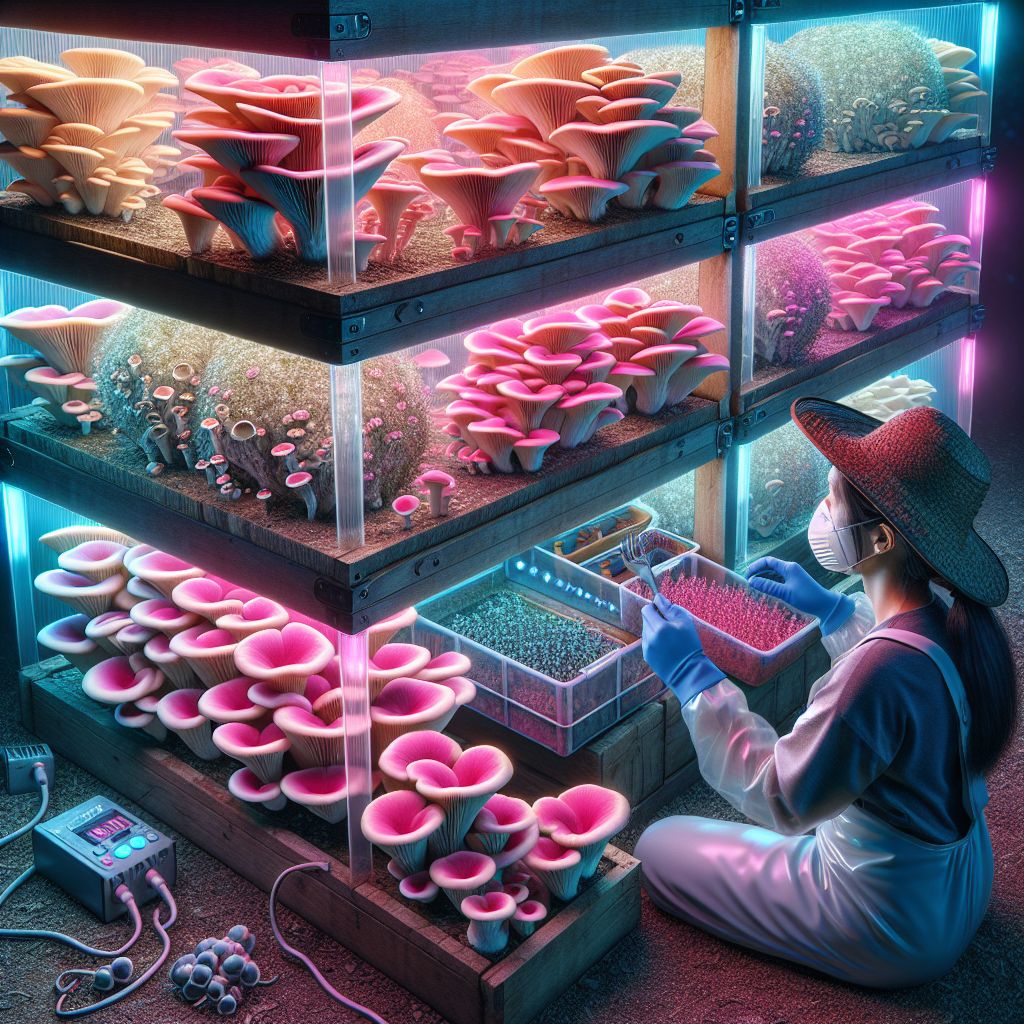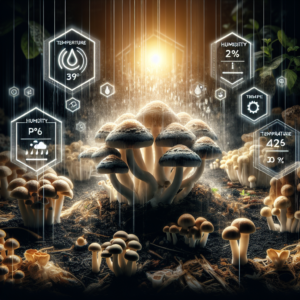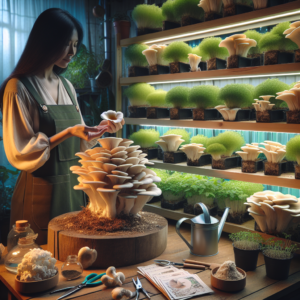
Key Takeaways
- Pink oyster mushrooms are an excellent choice for urban indoor farming due to their attractive appearance and ease of cultivation.
- Understanding the specific growing requirements of pink oyster mushrooms is key to successful cultivation, including temperature, humidity, and substrate preferences.
- Advanced lighting techniques can significantly enhance the growth and yield of pink oyster mushrooms, making year-round cultivation possible.
- With the right setup, urban dwellers can transform their homes into productive mushroom farms, regardless of outdoor space limitations.
- Consistent conditions and proper care can lead to a sustainable, continuous supply of fresh, home-grown pink oyster mushrooms.
Imagine transforming a corner of your apartment into a lush, pink oasis brimming with fresh oyster mushrooms, ready to be plucked and added to your dinner plate. It’s not just a dream; it’s a real possibility. Urban indoor farming, specifically cultivating pink oyster mushrooms, is a sustainable practice that’s accessible to everyone, even if you’re living in a high-rise with no garden in sight. Let’s dive in and learn how to bring this delightful slice of nature into your urban dwelling.
Making the Most of Your Urban Space for Mushroom Cultivation
Mushrooms are one of the most space-efficient crops you can grow. They don’t require sunlight, which means they can thrive in places that other plants can’t. And since they grow vertically, they use less horizontal space. That’s why pink oyster mushrooms are perfect for urban farmers looking to maximize their limited space.
Discovering the Pink Oyster Mushroom
These vibrant mushrooms aren’t just pretty; they’re also packed with flavor and nutrients. Pink oyster mushrooms have a meaty texture and a slight seafood flavor, making them a favorite among vegetarians and meat-eaters alike. Besides that, they’re known for their rapid growth cycle, which means you can enjoy multiple harvests in a season.
Space Efficiency in Urban Mushroom Farming
Because they grow in clusters and have a vertical growing habit, pink oyster mushrooms are ideal for small spaces. You can cultivate them in buckets, bags, or boxes, stacked on shelves, which means even a tiny apartment can become a productive farm.
Basics of Pink Oyster Mushrooms
Before you start your urban farming adventure, it’s crucial to understand the basics. Pink oyster mushrooms are a tropical species, which means they love warmth and humidity. They are also saprotrophic, feeding on dead organic material, which makes them perfect for recycling kitchen waste into something delicious.
Characteristics of Pink Oyster Mushrooms
The salmon-pink caps of these mushrooms are not only attractive but are also a sign of their freshness. As they mature, their color fades, and they become more delicate. They grow in shelf-like clusters, which makes harvesting them a breeze. Most importantly, their fast growth means you can go from spores to harvest in just a few weeks.
Ideal Conditions for Growing Pink Oysters
To successfully cultivate pink oyster mushrooms, you need to recreate their natural tropical environment. This includes:
- A temperature range between 65°F and 85°F, with the sweet spot being around 75°F.
- High humidity levels, typically between 70% and 80%, to keep the mushrooms moist and promote growth.
- A suitable substrate, such as straw or hardwood sawdust, which provides the necessary nutrients for the mushrooms to thrive.
But there’s one more factor that’s often overlooked, yet it’s crucial for optimal growth: lighting. While mushrooms don’t photosynthesize like plants, they still need light to guide their growth. That’s where advanced lighting techniques come into play.
Lighting: The Core of Urban Mushroom Farming
Lighting is the heartbeat of urban mushroom farming. It’s not just about making sure your mushrooms can see where they’re growing; it’s about providing them with the right kind of light to encourage healthy, robust growth.
Why does light matter so much? Well, it helps the mushrooms determine which direction to grow. In the wild, they’d grow towards natural light, but indoors, we need to replicate that cue. The good news is, with the right setup, you can create a perfect environment for your mushrooms, no matter the season or weather outside.
Stay tuned for the next segment where we’ll delve deeper into the types of lights you can use, how to control light intensity and duration, and how to optimize light spectrums to ensure your pink oyster mushrooms are not just surviving, but thriving. Remember, with a bit of knowledge and some simple equipment, you can transform your living space into a year-round mushroom farm. Let’s get growing!
Lighting: The Core of Urban Mushroom Farming
When it comes to indoor mushroom farming, one might wonder if mushrooms even need light, considering they don’t rely on photosynthesis. The answer is yes, but not for the same reasons plants do. Mushrooms use light as a signal for when and where to grow, which is why lighting is an essential component of urban mushroom cultivation.
Why Lighting Matters for Mushrooms
Lighting plays a critical role in mushroom development. It influences not just the direction of growth, but also the overall health of the mushroom. For pink oyster mushrooms, light helps initiate the pinning process, where small mushroom buds begin to form. Without adequate light, mushrooms can grow into odd shapes, which might affect their marketability and your personal aesthetic enjoyment.
But it’s not just any light that does the trick. Mushrooms are sensitive to the spectrum of light they receive. For instance, blue light is known to encourage more prolific fruiting in pink oyster mushrooms. Therefore, understanding and manipulating light in your growing area can make a huge difference in your mushroom farming success.
Types of Lights Used in Indoor Mushroom Cultivation
The type of light you choose for your indoor mushroom farm can have a significant impact on your yield. Here are some common options:
- Fluorescent lights: These are energy-efficient and provide a good spectrum of light for mushroom growth. They’re particularly suitable for small-scale operations.
- LED lights: LEDs are becoming increasingly popular due to their longevity and lower heat output. They also allow for customization of light spectrums, which can be tailored to the needs of pink oyster mushrooms.
- Incandescent lights: These are less common due to their high heat output and lower energy efficiency. They are not typically recommended for mushroom cultivation.
Advanced Lighting Techniques
Now that you know the importance of light and the types of lights available, let’s discuss how to apply this knowledge through advanced lighting techniques. These strategies can help you maximize your mushroom growth and produce a bountiful harvest all year round.
Controlling Light Intensity and Duration
Light intensity refers to how bright the light is, while duration is about how long the light is on. For pink oyster mushrooms, you’ll want to provide a gentle but consistent light source. A common practice is to use a timer to simulate a natural day/night cycle, with 12 hours of light and 12 hours of darkness. This rhythm encourages the mushrooms to grow in a natural pattern.
As for intensity, pink oyster mushrooms don’t require intense light. A low to medium level of brightness, similar to indirect sunlight, is ideal. This can be achieved by placing lights a few feet away from the growing area or by using a diffuser to soften the light’s impact.
Adjusting these parameters is essential when you’re trying to grow mushrooms in different seasons or if your indoor environment has varying levels of natural light. By controlling the intensity and duration of light, you can create a consistent growing environment that leads to predictable and successful harvests.
Optimizing Spectrums for Pink Oyster Growth
Remember when we mentioned blue light? Well, it turns out that pink oyster mushrooms respond best to a spectrum that includes blue wavelengths. LED lights are particularly useful for this because you can select bulbs that emphasize the blue spectrum, encouraging better fruiting and more vibrant mushroom caps.
Another aspect to consider is the red spectrum, which can also play a role in mushroom development. Some growers experiment with combining blue and red light to see what effect it has on their crop. It’s all about finding the right balance for your specific setup and mushroom strain.
Year-Round Cultivation Strategies
One of the beauties of indoor mushroom farming is the ability to produce crops all year round, regardless of the weather outside. But to do this successfully, you need to maintain consistent growing conditions.
Maintaining Consistent Growing Conditions
To keep your pink oyster mushrooms happy, you’ll need to manage not just lighting, but also temperature and humidity. A consistent temperature around 75°F and humidity levels between 70% and 80% are ideal. This can be achieved with a combination of heaters, humidifiers, and fans to circulate air and prevent mold growth.
Regular monitoring is crucial. Small changes in the environment can have big impacts on your mushrooms, so investing in a good quality thermometer and hygrometer to keep track of these conditions is a wise move.
Scaling Production in Urban Environments
As you get more comfortable with the basics of mushroom cultivation, you might consider scaling up your operation. Here’s a simple way to think about scaling:
- Space: Look for ways to use vertical space with shelving units to increase your growing area.
- Efficiency: Invest in better equipment that can automate temperature and humidity control.
- Productivity: Experiment with different substrates and strains to find the most productive combination for your environment.
With these strategies in place, you can create an efficient, productive indoor mushroom farm that can operate year-round, providing you with a continuous supply of fresh mushrooms.
Turn Your Urban Home Into a Mushroom Delight
Setting up your indoor mushroom farm can be a fun and rewarding project. You’ll need to create a dedicated space for your mushrooms, gather your materials, and prepare your substrate. Once you’ve inoculated your substrate with mushroom spores or spawn, you’ll be on your way to your first harvest.
Here’s a quick rundown of the process:
- Choose a location in your home that’s free from drafts and can be kept at a consistent temperature and humidity level.
- Set up your lighting system, ensuring it provides the correct spectrum and intensity for pink oyster mushrooms.
- Prepare your substrate using materials like straw or sawdust, which you can pasteurize to kill off any unwanted organisms.
- Inoculate your substrate with pink oyster mushroom spawn, which you can purchase from a reputable supplier.
- Maintain your growing environment, monitoring and adjusting temperature, humidity, and light as needed.
- Harvest your mushrooms when they’re mature, but before their caps fully uncurl.
And there you have it! With a little bit of setup and care, you can enjoy fresh, home-grown pink oyster mushrooms right from your urban abode. It’s a sustainable, satisfying way to produce your own food and contribute to a healthier planet. So why not give it a try? Your taste buds and the environment will thank you.
Setting up your indoor mushroom farm can be a fun and rewarding project. You’ll need to create a dedicated space for your mushrooms, gather your materials, and prepare your substrate. Once you’ve inoculated your substrate with mushroom spores or spawn, you’ll be on your way to your first harvest.
From Spawn to Harvest: A Step-by-Step Guide
Here’s a quick rundown of the process:
- Choose a location in your home that’s free from drafts and can be kept at a consistent temperature and humidity level.
- Set up your lighting system, ensuring it provides the correct spectrum and intensity for pink oyster mushrooms.
- Prepare your substrate using materials like straw or sawdust, which you can pasteurize to kill off any unwanted organisms.
- Inoculate your substrate with pink oyster mushroom spawn, which you can purchase from a reputable supplier.
- Maintain your growing environment, monitoring and adjusting temperature, humidity, and light as needed.
- Harvest your mushrooms when they’re mature, but before their caps fully uncurl.
And there you have it! With a little bit of setup and care, you can enjoy fresh, home-grown pink oyster mushrooms right from your urban abode. It’s a sustainable, satisfying way to produce your own food and contribute to a healthier planet. So why not give it a try? Your taste buds and the environment will thank you.
Frequently Asked Questions
What Makes Pink Oyster Mushrooms Suitable for Urban Farming?
Pink oyster mushrooms are ideal for urban farming because they require minimal space and can thrive in controlled environments. Their fast growth cycle and preference for higher temperatures make them suitable for indoor cultivation, where conditions such as light and humidity can be easily managed.
How Does Advanced Lighting Affect Mushroom Quality?
Advanced lighting techniques can greatly enhance the quality and yield of pink oyster mushrooms. By providing the right light spectrum, intensity, and duration, you can stimulate more uniform growth, improve the color and texture of the mushrooms, and potentially increase the speed of the growth cycle.
Can I Grow Pink Oyster Mushrooms Year-Round Without Advanced Equipment?
While advanced equipment can optimize your growing conditions, it’s possible to grow pink oyster mushrooms year-round with a basic setup. You’ll need to be more attentive to environmental changes and may have to adjust your cultivation practices to accommodate seasonal variations in temperature and light.
How Much Space Do I Need to Start an Indoor Mushroom Farm?
You can start an indoor mushroom farm in a surprisingly small space. A shelf in a closet, a corner of your living room, or a section of your kitchen can be enough. The key is to utilize vertical space and ensure the environment can be controlled for temperature and humidity.


